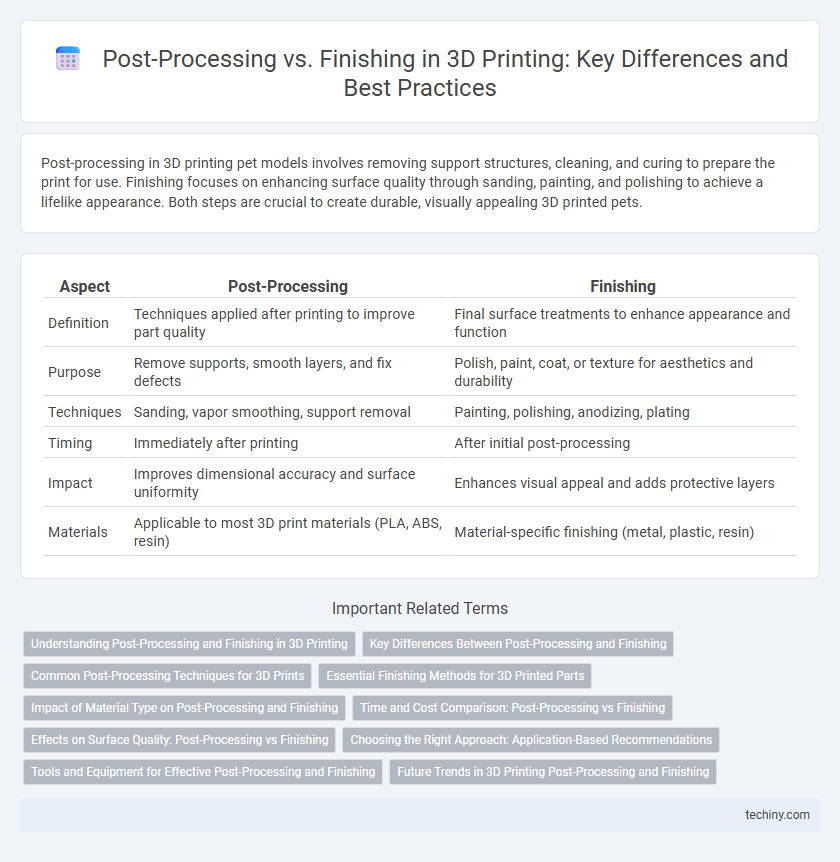Post-processing in 3D printing pet models involves removing support structures, cleaning, and curing to prepare the print for use. Finishing focuses on enhancing surface quality through sanding, painting, and polishing to achieve a lifelike appearance. Both steps are crucial to create durable, visually appealing 3D printed pets.
Table of Comparison
| Aspect | Post-Processing | Finishing |
|---|---|---|
| Definition | Techniques applied after printing to improve part quality | Final surface treatments to enhance appearance and function |
| Purpose | Remove supports, smooth layers, and fix defects | Polish, paint, coat, or texture for aesthetics and durability |
| Techniques | Sanding, vapor smoothing, support removal | Painting, polishing, anodizing, plating |
| Timing | Immediately after printing | After initial post-processing |
| Impact | Improves dimensional accuracy and surface uniformity | Enhances visual appeal and adds protective layers |
| Materials | Applicable to most 3D print materials (PLA, ABS, resin) | Material-specific finishing (metal, plastic, resin) |
Understanding Post-Processing and Finishing in 3D Printing
Post-processing in 3D printing involves essential steps like support removal, surface smoothing, and curing to prepare the printed object for functional use or further treatment. Finishing focuses on enhancing the aesthetic and tactile qualities through techniques such as sanding, painting, and coating. Distinguishing these phases ensures optimal structural integrity and visual appeal in additively manufactured parts.
Key Differences Between Post-Processing and Finishing
Post-processing in 3D printing involves removing support structures, cleaning, and curing the printed object to prepare it for use or further refinement. Finishing refers specifically to the final surface treatments like sanding, painting, or coating that enhance aesthetics and functionality. Key differences lie in post-processing focusing on structural preparation, while finishing targets visual and tactile improvements.
Common Post-Processing Techniques for 3D Prints
Common post-processing techniques for 3D prints include sanding, which smooths surface imperfections and prepares the model for further refinement. Chemical smoothing, such as acetone vapor treatment for ABS prints, enhances surface finish by melting outer layers to create a glossy appearance. Support removal and priming are essential steps that ensure structural integrity and optimal paint adhesion, respectively, improving the overall quality and durability of the final 3D printed object.
Essential Finishing Methods for 3D Printed Parts
Essential finishing methods for 3D printed parts include sanding, polishing, and painting, which enhance surface smoothness and visual appeal. Chemical smoothing techniques, such as acetone vapor treatment for ABS prints, improve durability and reduce layer visibility. Applying primers and clear coats protects the parts from environmental damage while providing a professional finish.
Impact of Material Type on Post-Processing and Finishing
Material type significantly influences post-processing and finishing techniques in 3D printing, affecting factors such as surface quality, durability, and appearance. Thermoplastics like PLA and ABS require sanding and polishing to reduce layer lines, while resin prints benefit from UV curing and solvent smoothing to enhance clarity and strength. Metals demand specialized treatments like heat treatment and machining to achieve desired mechanical properties and finish standards.
Time and Cost Comparison: Post-Processing vs Finishing
Post-processing in 3D printing often requires more time and higher costs due to multiple steps like support removal, sanding, and curing, which are essential for making the part functional. Finishing typically involves fewer, less labor-intensive processes such as painting or coating, resulting in faster completion and lower expenses. Choosing between post-processing and finishing depends on the desired quality, complexity, and budget constraints of the 3D printed part.
Effects on Surface Quality: Post-Processing vs Finishing
Post-processing in 3D printing involves initial steps such as support removal, sanding, and cleaning to eliminate surface imperfections and improve dimensional accuracy. Finishing techniques, including painting, coating, and polishing, further enhance surface smoothness, visual appeal, and durability of the printed parts. The combined application of post-processing and finishing significantly elevates surface quality, making parts suitable for functional or aesthetic use.
Choosing the Right Approach: Application-Based Recommendations
Choosing the right post-processing or finishing technique in 3D printing depends on the specific application requirements such as desired surface quality, mechanical strength, and aesthetic appeal. Functional prototypes benefit from minimal post-processing to preserve dimensional accuracy, while end-use parts require advanced finishing methods like sanding, painting, or chemical smoothing to enhance durability and appearance. Material type, such as PLA, ABS, or resin, also significantly influences the choice between post-processing techniques like support removal, curing, or polishing for optimal results.
Tools and Equipment for Effective Post-Processing and Finishing
Post-processing and finishing in 3D printing require specialized tools such as sanding machines, rotary tools, and precision knives to refine surface texture and remove support structures. Equipment like ultrasonic cleaners and vapor polishers enhance detail clarity and achieve smooth, glossy finishes by eliminating residue and layer lines. Selecting the right combination of hardware ensures efficient handling of different materials, improving final print quality and structural integrity.
Future Trends in 3D Printing Post-Processing and Finishing
Emerging technologies in 3D printing post-processing and finishing focus on automation and enhanced surface quality through advanced robotic systems and AI-driven quality control. Innovations like laser polishing, chemical vapor smoothing, and multi-material integration are revolutionizing the efficiency and precision of finishing processes. Future trends emphasize sustainable practices and real-time monitoring, enabling faster production cycles and superior end-use part aesthetics in industries such as aerospace, automotive, and healthcare.
Post-processing vs Finishing Infographic

 techiny.com
techiny.com